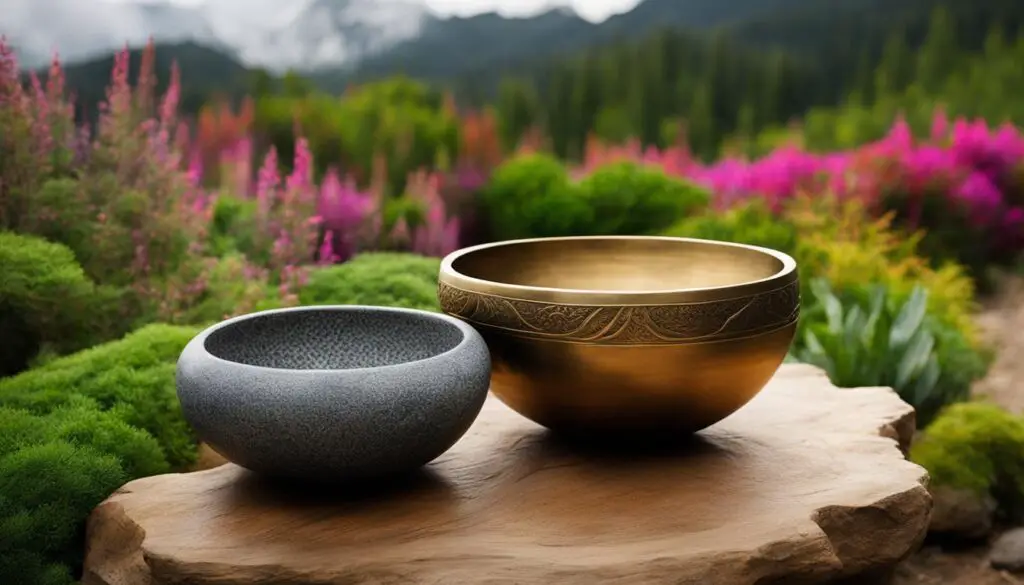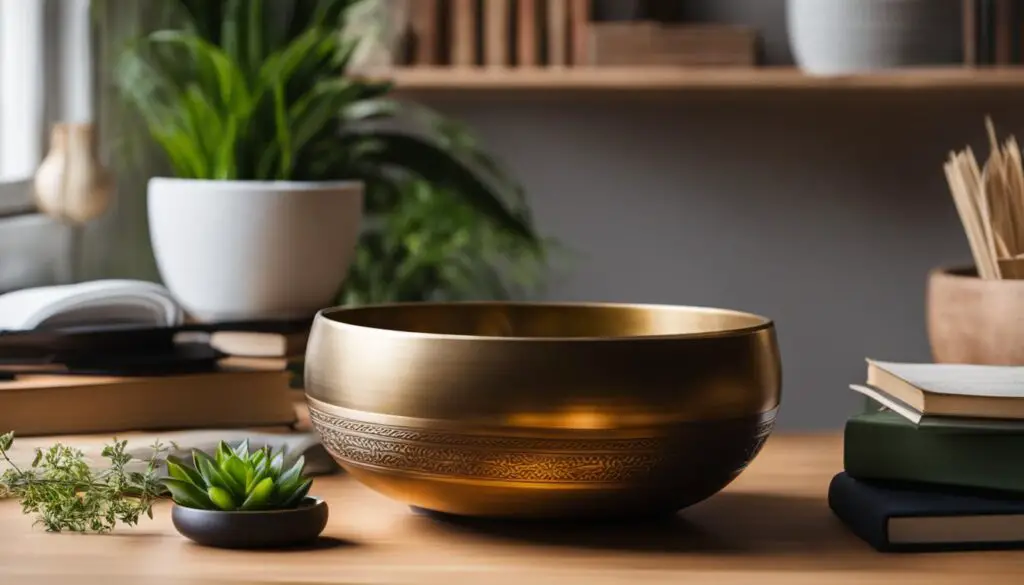Singing bowls, also known as Tibetan singing bowls or Himalayan bowls, have gained popularity in Western countries for their ability to promote relaxation and provide sound healing. These bowls produce a rich, deep tone when played and are often used in meditation and relaxation practices. They are believed to have numerous benefits, including stress relief and increased mindfulness. The origins of singing bowls are still debated, but they are believed to have originated in China thousands of years ago. Over time, they have evolved and are now available in various materials, including metal and crystal. Singing bowls have become a valuable tool for those seeking inner tranquility and spiritual healing.
Key Takeaways:
- Singing bowls are used for relaxation and sound healing.
- They produce a rich, deep tone and are often used in meditation and relaxation practices.
- Singing bowls have origins in China and have evolved over time.
- They are available in various materials, including metal and crystal.
- Singing bowls are a valuable tool for promoting inner tranquility and spiritual healing.
What Are Singing Bowls and How Are They Used?
Singing bowls are a type of bowl that vibrates and produces a resonant sound when played. They are commonly used in meditation and sound therapy practices to promote relaxation and enhance mindfulness. During meditation, the bowls can be struck or rubbed with a mallet, creating soothing sounds and vibrations that help calm the mind and body. The vibrations produced by the bowls are believed to have a harmonizing effect on the cells of the body and can help balance the body’s energy system. The use of singing bowls in sound therapy has also been associated with pain relief and immune system stimulation. Overall, singing bowls are versatile tools that can be incorporated into various practices for enhanced well-being.
Using Singing Bowls in Meditation
One of the primary uses of singing bowls is in meditation. When played, these bowls emit a tone that can help individuals enter a deep state of relaxation and focus. The soothing sounds and vibrations of the bowls create a calming atmosphere, allowing practitioners to let go of stress and distractions. As the body and mind become more relaxed, meditation becomes easier, and individuals can experience a greater sense of peace and mindfulness.
Singing bowls can be incorporated into meditation practices in different ways. Some practitioners prefer to strike the bowl once at the beginning and end of their meditation session to mark the start and finish. Others may choose to continuously play the bowl throughout their practice, focusing on the sound and vibration as a point of concentration. Experimenting with different techniques can help individuals find the approach that works best for them.
Sound Therapy and Singing Bowls
Singing bowls are also widely used in sound therapy, a holistic healing practice that utilizes the power of sound vibrations to bring about physical and emotional well-being. During a sound therapy session, the practitioner uses various instruments, including singing bowls, to create a healing soundscape. The soothing sounds and vibrations produced by the bowls can help to reduce stress, relieve tension, and promote relaxation.
In sound therapy, the bowls are often played in combination with other instruments, such as chimes, drums, or gongs, to create a harmonious and immersive experience. The different sounds and frequencies produced by these instruments work together to balance and restore the body’s energy system. Sound therapy sessions can be deeply therapeutic and provide a sense of profound relaxation and rejuvenation.
In conclusion, singing bowls are versatile tools that can be used in meditation and sound therapy to promote relaxation, mindfulness, and overall well-being. Whether struck or rubbed with a mallet, these bowls produce soothing sounds and vibrations that have a harmonizing effect on the body and mind. Through their use, individuals can experience a deep state of relaxation, enhanced focus, and a greater sense of peace. Whether used in personal practice or as part of professional healing modalities, singing bowls offer a powerful tool for harnessing the healing power of sound vibrations.
The Symbolism and Variations of Singing Bowls
Singing bowls hold deep symbolism and vary among different sects and traditions. In Tibetan Buddhism, the bowls are often seen as representations of the unity of body, speech, and mind. The circular shape of the bowl symbolizes the perfection of wisdom, while the sound it produces represents the enlightened mind. Different sects may have variations in the design and materials used for the bowls, but the overall symbolism remains consistent. Singing bowls are also used in other spiritual practices, such as Hinduism and New Age spirituality, where they may hold different meanings and uses.
Within Tibetan Buddhism, variations in singing bowls can be seen in their physical appearance and the materials used to craft them. The shape of the bowl may differ, ranging from shallow to deep, and the size can vary as well. Additionally, the materials used can include metal alloys such as brass or bronze, as well as precious metals like silver or gold. The specific combination of metals and their ratios can differ, leading to variations in the sound produced. Some practitioners believe that the specific materials used can impact the bowl’s healing properties and resonance.
| Sect | Variations | Symbolism |
|---|---|---|
| Tibetan Buddhism | Different bowl shapes and sizes, variations in metal alloys and ratios | Unity of body, speech, and mind; representation of enlightened mind |
| Hinduism | Similar bowl shapes, variations in materials and ornamentation | Used in rituals and ceremonies, associated with specific deities and spiritual practices |
| New Age Spirituality | Various bowl shapes, alternative materials like crystal or gemstones | Used for energy healing, chakra balancing, and spiritual connection |
It is important to note that while there are variations in the symbolism and physical attributes of singing bowls, the core intention remains the same – to create a sacred space for healing, meditation, and spiritual connection. The diversity in singing bowl variations adds to the richness and depth of this ancient practice, allowing individuals to find resonance with their specific beliefs and needs.
Materials Used in Singing Bowls and Their Evolution Over Time
Singing bowls have a long history and have evolved over time, with changes in the materials used to create them. Traditionally, Tibetan singing bowls were made from a combination of metals, including copper, iron, silver, gold, and even mercury. Each metal was believed to carry its own unique properties, contributing to the therapeutic effects of the bowls.
Over the years, the materials used in singing bowls have expanded, and now they are also available in crystal and other substances. Crystal singing bowls, for example, are highly regarded for their pure and clear sound compared to traditional metal bowls. The use of different materials has provided practitioners with more options, allowing them to choose bowls that resonate with their specific needs and preferences.
Here is a complete table summarizing the materials used in singing bowls and their characteristics:
| Material | Characteristics |
|---|---|
| Metal (copper, iron, silver, gold, mercury) | Traditional and widely used. Each metal is believed to carry unique properties that contribute to therapeutic effects. |
| Crystal (quartz, gemstones) | Provides a purer and clearer sound compared to metal bowls. Highly regarded for their resonance and vibrational qualities. |
| Other materials (wood, ceramic, etc.) | Offer unique aesthetics and sound qualities. Some materials may have specific cultural or symbolic significance. |
While metal and crystal bowls are the most common, there is a growing variety of singing bowls made from different materials, each with its own distinct characteristics and benefits.

Unique and Lesser-Known Singing Bowl Tools
While singing bowls are the most well-known and widely used tools for sound healing, there are also other unique and lesser-known tools in this field. These tools offer alternative ways to incorporate sound and vibration into healing practices, providing practitioners and individuals with a broader range of options for promoting well-being.
One of these unique tools is the tingsha, a small flat round bronze bell that produces a clear, high-pitched sound when struck. Tingshas are often used in ceremonies and rituals as a way to clear negative energy and bring about a sense of peace and harmony. Their distinctive tone and resonance make them a valuable addition to sound healing practices.
Another lesser-known tool frequently used in sound healing is the gong. Gongs produce a deep, resonating sound that can reach deep into the body, facilitating relaxation and a sense of inner calm. The vibrations created by gongs can have a profound effect on the mind and body, making them a powerful tool in sound healing therapies.
“The tingsha and gong are unique instruments that add depth and dimension to sound healing practices. Incorporating their sounds into sessions can create a truly transformative experience for individuals seeking relaxation and healing.”
Integrating these unique tools alongside singing bowls can enhance the overall sound healing experience, allowing for a more personalized and tailored approach. By exploring different tools and their individual characteristics, practitioners and individuals can discover the combination that resonates most with their intentions and desired outcomes.
Table: Unique Singing Bowl Tools
| Tool | Description |
|---|---|
| Tingsha | A small flat round bronze bell that produces a clear, high-pitched sound when struck. Often used in ceremonies and rituals to clear negative energy and promote peace and harmony. |
| Gong | A large percussion instrument that produces a deep, resonating sound when struck. Used in sound healing practices to facilitate relaxation and promote a sense of inner calm. |
The Benefits and Effects of Singing Bowl Therapy
Singing bowl therapy has gained recognition for its ability to promote relaxation, sound healing, and overall well-being. The resonant tones and vibrations produced by singing bowls have a profound impact on the mind, body, and spirit, offering numerous benefits for those who incorporate them into their practices and daily lives. Here are some of the key benefits and effects of singing bowl therapy:
Stress Relief and Relaxation
One of the primary benefits of singing bowl therapy is stress relief. The soothing sounds and vibrations produced by the bowls can create a sense of calm and tranquility, helping individuals unwind and alleviate tension. The resonant tones synchronize with the brainwaves, inducing a meditative state and promoting deep relaxation.
Enhanced Meditation and Mindfulness
Singing bowls are commonly used as meditation tools due to their ability to deepen the meditative experience. The sound and vibrations produced by the bowls help individuals enter a state of deep focus and presence, enhancing mindfulness and promoting a sense of inner tranquility. By incorporating singing bowls into meditation practices, individuals can achieve a heightened sense of awareness and clarity.
Improved Sleep Quality
Many people struggle with sleep-related issues such as insomnia or restless nights. Singing bowl therapy can help improve sleep quality by promoting relaxation and reducing stress levels. The soothing sounds and vibrations of the bowls create a serene environment that can ease the mind and body into a state of deep relaxation, facilitating a restful night’s sleep.
| Benefits of Singing Bowl Therapy |
|---|
| Stress relief |
| Enhanced meditation and mindfulness |
| Improved sleep quality |
Singing bowl therapy is a versatile practice that can be beneficial for individuals seeking stress relief, enhanced meditation experiences, and improved sleep. Incorporating singing bowls into daily routines or professional healing practices can provide a holistic approach to well-being, promoting relaxation and sound healing.
Using Singing Bowls in Combination with Other Healing Practices
Singing bowls, with their soothing sounds and vibrations, can be effectively used in combination with other healing practices to enhance their overall effectiveness. Whether it’s meditation, deep breathing exercises, or various therapeutic modalities, incorporating singing bowls can deepen the experience and promote a profound sense of relaxation and well-being.
The Power of Singing Bowls in Meditation
Meditation is a practice that cultivates mindfulness and inner peace. By incorporating singing bowls into meditation sessions, individuals can enhance their ability to enter a deep meditative state and experience profound relaxation. The gentle and soothing sounds produced by the bowls help quiet the mind and create a calm and serene environment. As the vibrations resonate through the body, they promote a sense of harmony and balance, aiding in the release of stress and tension.
Deep Breathing and Singing Bowl Harmony
Deep breathing exercises are known for their ability to induce relaxation and reduce anxiety. Combining deep breathing with the sounds of singing bowls further amplifies the benefits. As individuals focus on their breath, the harmonious tones of the bowls help synchronize their breathing rhythm, creating a calming and meditative experience. The vibrations produced by the bowls resonate deeply within the body, encouraging a state of deep relaxation and heightened awareness.
| Healing Practice | How Singing Bowls Can Enhance |
|---|---|
| Meditation | Deepens the meditative experience, promotes relaxation, and supports inner peace. |
| Deep Breathing Exercises | Amplifies the relaxation effects, synchronizes breath with vibrations, and fosters mindfulness. |
“The combination of singing bowls with other healing practices creates a synergistic effect, enhancing relaxation, mindfulness, and overall well-being.”
Enhanced Therapeutic Benefits
Professionals in the wellness and healing arts, including music therapists, massage therapists, and yoga therapists, can integrate singing bowls into their practices to enhance the therapeutic benefits for their clients. The soothing sounds and vibrations of the bowls create a deeply immersive experience, facilitating relaxation, pain relief, and a greater sense of well-being. By incorporating singing bowls into their sessions, practitioners can tap into the transformative power of sound and vibration, offering a unique and effective tool for healing and self-discovery.
Using singing bowls in combination with other healing practices can create a harmonious blend of modalities that synergistically support relaxation, mindfulness, and holistic well-being. By integrating the soothing sounds and vibrations of singing bowls into meditation sessions, deep breathing exercises, and therapeutic practices, individuals can enhance their healing journey and experience profound states of tranquility and inner peace.
The Use of Singing Bowls in Personal and Professional Settings
Singing bowls are versatile tools that can be used both personally and professionally to promote relaxation and well-being. In personal settings, many individuals incorporate singing bowls into their meditation or mindfulness practices. These ancient instruments create a peaceful and serene environment, helping individuals enter a state of deep relaxation and tranquility. The soothing sounds and vibrations produced by the bowls enhance the meditative experience, allowing for a more profound sense of calm and presence.
Professionals in the wellness and healing arts also utilize singing bowls to enhance their therapeutic practices. Music therapists, massage therapists, and yoga therapists incorporate singing bowls into their sessions as a way to deepen the therapeutic experience for their clients. The captivating sounds and vibrations of the bowls complement other modalities, such as massage or yoga, and create a more immersive and holistic healing environment.
Whether used personally or professionally, singing bowls offer a unique and immersive way to incorporate sound and vibration into relaxation and healing practices. Their ability to induce a state of deep relaxation and promote mindfulness has made them a valuable tool for individuals seeking inner tranquility and spiritual healing, as well as professionals in various healing modalities.

Table: Singing Bowls in Personal and Professional Settings
| Setting | Use |
|---|---|
| Personal | Incorporated into meditation and mindfulness practices to create a peaceful and serene environment, promoting relaxation and deepening the meditative experience. |
| Professional | Utilized by wellness and healing arts professionals, such as music therapists, massage therapists, and yoga therapists, to enhance their therapeutic sessions and create a more immersive and holistic healing environment. |
“The captivating sounds and vibrations of singing bowls complement other healing modalities, creating a more immersive and holistic healing environment.” – Music Therapist
Conclusion
Singing bowls have a rich history and are widely recognized for their ability to promote relaxation and provide sound healing benefits. These versatile prayer tools have been used for centuries in various spiritual practices, such as meditation and sound therapy, to create a soothing and harmonious environment. The deep tones and vibrations produced by singing bowls help calm the mind and body, allowing individuals to achieve a state of deep relaxation and inner peace.
Although the origins of singing bowls are still a topic of debate, their popularity continues to grow as more people discover their unique qualities. Singing bowls are believed to have multiple benefits, including stress relief, increased mindfulness, and a harmonizing effect on the body’s energy system. These tools hold symbolic significance, representing unity and enlightenment in different sects and traditions.
Over time, singing bowls have evolved in terms of the materials used. Traditionally made from a combination of metals, such as copper and silver, they are now also available in crystal and other materials. Crystal singing bowls, in particular, are highly regarded for their pure and clear sound. Additionally, there are other lesser-known tools in the field of sound healing, such as tingshas and gongs, which offer alternative ways to incorporate sound and vibration into healing practices.
Whether used personally or professionally, singing bowls offer a powerful tool for relaxation and self-care. Their therapeutic effects on the mind, body, and spirit have been reported by individuals worldwide. While more scientific research is needed to fully understand their mechanisms of action, the profound experiences and benefits observed suggest that singing bowls have the potential to be a valuable tool for promoting relaxation, sound healing, and overall well-being.
FAQ
What are singing bowls?
Singing bowls are bowls that vibrate and produce a resonant sound when played. They are commonly used in meditation and sound therapy practices to promote relaxation and enhance mindfulness.
How are singing bowls used?
Singing bowls can be struck or rubbed with a mallet to create soothing sounds and vibrations. These vibrations help calm the mind and body, making them a valuable tool for enhancing meditation practices and promoting relaxation.
What is the symbolism and variation of singing bowls?
Singing bowls hold symbolic significance and vary among different sects and traditions. In Tibetan Buddhism, for example, they represent the unity of body, speech, and mind. Different sects may have variations in design and materials used, but the overall symbolism remains consistent.
What materials are used in singing bowls?
Singing bowls were traditionally made from a combination of metals such as copper, iron, silver, gold, and even mercury. However, they are now also available in crystal and other materials. Crystal singing bowls are believed to have a purer and clearer sound compared to metal bowls.
Are there any other unique singing bowl tools?
Yes, there are other unique tools in the field of sound healing. Tingshas, for example, are small flat round bronze bells that produce a clear, high-pitched sound when struck. Gongs are another tool commonly used in sound healing, producing a deep, resonating sound.
What are the benefits of singing bowl therapy?
Singing bowl therapy is believed to promote relaxation, reduce stress, improve sleep quality, and decrease symptoms of anxiety and depression. The vibrations and sounds produced by the bowls can induce a meditative state and help balance and harmonize the body’s energy system.
How can singing bowls be used in combination with other healing practices?
Singing bowls can be incorporated into meditation sessions to deepen the meditative experience and promote a sense of profound relaxation. They can also be used during deep breathing exercises to enhance relaxation and mindfulness.
Can singing bowls be used in personal and professional settings?
Absolutely. Many individuals incorporate singing bowls into their personal meditation or mindfulness practices, using them as tools to create a peaceful environment. Professionals in the wellness and healing arts, such as music therapists and yoga therapists, may also utilize singing bowls in their practices to enhance the therapeutic experience for their clients.
What makes singing bowls a valuable tool for relaxation?
Singing bowls have a rich history and are widely recognized for their ability to promote relaxation and provide sound healing benefits. Their unique qualities and therapeutic effects make them a powerful tool for enhancing relaxation, mindfulness, and overall well-being.








